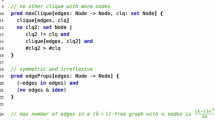Abstract
Alloy [Jac02a] is a widely adopted relational modeling language. Its appealing syntax and the support provided by the Alloy Analyzer [Jac02b] tool make model analysis accessible to a public of non-specialists. A model and property are translated to a propositional formula, which is fed to a SAT-solver to search for counterexamples. The translation strongly depends on user-provided bounds for data domains called scopes - the larger the scopes, the more confident the user is about the correctness of the model. Due to the intrinsic complexity of the SAT-solving step, it is often the case that analyses do not scale well enough to remain feasible as scopes grow.
Similar content being viewed by others
References
Andersen, H.R., Hulgaard, H.: Boolean expression diagrams. Information and computation 179(2), 194–212 (2002)
Eén, N., Sörensson, N.: An extensible sat solver. In: Giunchiglia, E., Tacchella, A. (eds.) SAT 2003. LNCS, vol. 2919, pp. 502–518. Springer, Heidelberg (2004)
Jackson, D.: Alloy: a lightweight object modelling notation. ACM Transactions on Software Engineering and Methodology 11(2), 256–290 (2002)
Jackson, D.: A micromodels of software: Lightweight modelling and analysis with Alloy. Computer Science and Artificial Intelligence Laboratory. MIT, Cambridge (2002)
Snir, M., Otto, S., Huss-Lederman, S., Walker, D., Dongarra, J.: MPI: The complete reference. MIT Press, Cambridge (1998)
Zave, P.: Compositional binding in network domains. In: Misra, J., Nipkow, T., Sekerinski, E. (eds.) FM 2006. LNCS, vol. 4085, pp. 332–347. Springer, Heidelberg (2006)
Author information
Authors and Affiliations
Editor information
Editors and Affiliations
Rights and permissions
Copyright information
© 2010 Springer-Verlag Berlin Heidelberg
About this paper
Cite this paper
Rosner, N., Galeotti, J.P., Lopez Pombo, C.G., Frias, M.F. (2010). ParAlloy: Towards a Framework for Efficient Parallel Analysis of Alloy Models. In: Frappier, M., Glässer, U., Khurshid, S., Laleau, R., Reeves, S. (eds) Abstract State Machines, Alloy, B and Z. ABZ 2010. Lecture Notes in Computer Science, vol 5977. Springer, Berlin, Heidelberg. https://doi.org/10.1007/978-3-642-11811-1_33
Download citation
DOI: https://doi.org/10.1007/978-3-642-11811-1_33
Publisher Name: Springer, Berlin, Heidelberg
Print ISBN: 978-3-642-11810-4
Online ISBN: 978-3-642-11811-1
eBook Packages: Computer ScienceComputer Science (R0)




